
French postcard by Europe, no. 547. Photo: Paramount.

French postcard by Europe, no. 630. Photo: Paramount.

German postcard by Ross Verlag, no. 3510/1, 1928-1929. Photo: Paramount.

German postcard by Ross-Verlag, no. 3980/3, 1928-1929. Photo: Paramount.
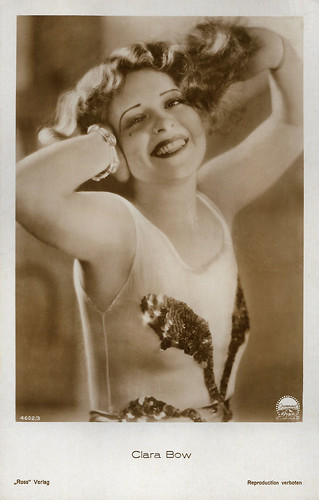
German postcard by Ross Verlag, no. 4602/3, 1929-1930. Photo: Paramount.

Italian postcard by Cinema-Illustrazione, series 1, no. 16. Photo: Paramount. Photo by George P. Hommel (1929).
The hottest jazz baby in films
Clara Gordon Bow was born in a run-down tenement in old Brooklyn in 1905 and was raised in poverty and violence. Her often absentee and brutish father, Robert Bow, who hailed from a large and once well-off family of Scottish and English descent, could not or did not provide.
Her schizophrenic mother, the former Sarah Gordon, tried to slit Clara's throat when the girl spoke of becoming an actress. Bow, nonetheless, Clara won a national photo beauty contest, "The Fame and Fortune Contest". Girls from all over the country competed, and the 1st Prize was a part in a film.
Bow showed up in ragged clothes and the other girls smirked at her. The contest judges paid no attention until she did her screen test - and then they unanimously chose her over all the other girls. Bow lit up the screen and got the part but it was later cut from the film. Clara was taken to Hollywood by independent producer B.P. Schulberg, who used her sexually and financially.
She would eventually star in 58 films, from 1922 to 1933. Schulberg billed her as "The Hottest Jazz Baby in Films" for The Plastic Age (Wesley Ruggles, 1925). Her other silent films included hits such as Mantrap (Victor Fleming, 1926), It (Clarence Badger, 1927), and Wings (William A. Wellman, 1927) with Charles 'Buddy' Rogers, Richard Arlen, and Gary Cooper. Denny Jackson at IMDb: "The movie It (1927) defined her career. The film starred Clara as a shopgirl who was asked out by the store's owner. As you watch the silent film you can see the excitement as she prepared for her date with the boss, her friend trying hard to assist her. She used a pair of scissors to modify her dress to try to look "sexier".
The movie did much to change society's mores as there were only a few years between World War I and Clara Bow, but this movie went a long way in how society looked at itself. Clara was a flaming youth in rebellion. In the film, she presented worldly wisdom that somehow sex meant having a good time. But the movie shouldn't mislead the viewer, because when her boss tries to kiss her goodnight, she slaps him."

French postcard by Cinémagazine-Edition, Paris, no. 122. Photo: Paramount.

Austrian postcard by Iris Verlag, no. 5464. Photo: Paramount.

French postcard by Cinémagazine-Edition, Paris, no. 649.

French postcard by Europe, no. 873. Photo: Paramount.

French postcard by A.N., Paris, no. 389. Photo: Paramount.
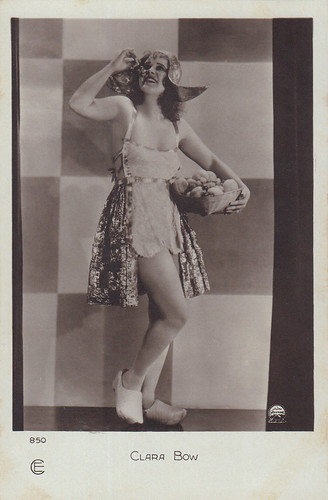
French postcard by Cinémagazine-Edition, Paris, no. 850. Photo: Films Paramount. Collection: Marlene Pilaete.

French postcard by Edition Ross, no. 4340/1, 1929-1930. Photo: Paramount. Clara Bow and Richard Arlen in Ladies of the Mob (William A. Wellman, 1928).
Flaming youth in rebellion
Clara Bow was named the first box-office draw in 1928 and 1929 and the second box-office draw in 1927 and 1930. Her presence in a motion pictures was said to have ensured investors, by odds of almost 2-to-1, a 'safe return". Maeve at IMDb: "She could flirt with the camera just by looking into it with her big brown eyes and mischievous bow-tie grin. She exuded sex appeal from every pore in her little body and was not afraid to flaunt it. She personified "flaming youth in rebellion". Her characters were always working-class gals; manicurists, showgirls, and the like. Her movies reportedly emancipated many young people from the restrictive morals of their parents."
At the apex of her stardom, she received more than 45,000 fan letters in a single month (January 1929). Also, she was probably the most overworked and underpaid star in the industry. With the coming of sound, her popularity waned. Clara was also involved in several court battles ranging from unpaid taxes to "stealing" women's husbands. She had very public affairs (her euphemism was "engagements") with a score of leading men and directors, including Victor Fleming, Gary Cooper, and Gilbert Roland.
Her secretary and best friend, Daisy de Voe, was caught embezzling from her. Nasty rumours about her sexuality floated around the movie colony, including one about her taking on the entire USC Football Team one night, which was finally disproved by a biographer, David Stenn. When Bow took de Voe to court, the secretary told the court about and the press reported uncensored details of Bow's sex life, much of which was exaggerated. After the court trials, Bow made a couple of attempts to get back in the public eye. One was Call Her Savage (John Francis Dillon, 1932), which Denny Jackson at IMDb calls "somewhat of a failure at the box office". In 1932, she married cowboy star Rex Bell and two years later, Bow retired from acting and became a rancher in Nevada. Her final film was Hoop-La (Frank Lloyd, 1933). But how (un)successful was the end of Clara's career?
Marlene Pilaete: "Sources differ regarding Call Her Savage’s success. Celluloid Club calls it a "huge hit". Film site.org calls it a "huge pre-Hays Code box-office hit". Clara Bow.net speaks of the film’s "healthy box office performance". Fascinating Women in California History says about Call Her Savage and Hoopla: “ Both were successful and financially rewarding”. The book 'Paramount Pretties' says "Call Her Savage made out quite nicely at the box office and promised a bright new future for Clara”. Wikipedia: “The film attracted an audience of over 900.000 when it was showcased in 42 first-run cities”. In his Clara Bow biography, David Stenn writes: "Call Her Savage proved that Clara was still a star. New York’s Roxy, the largest movie theatre in America, had its highest-grossing week since its reopening after renovations. In other cities, the stampede for tickets caused box offices to close early."
Clara doted on her two sons, actor Rex Bell Jr. (b. 1934) and George Robert (b. 1938), and did everything to please them. Haunted by a weight problem and a mental imbalance, she never re-entered show business. She was confined to sanitariums from time to time and prohibited access to her beloved sons. In 1965, Clara Bow died of a heart attack in West Los Angeles at the age of 60.

German postcard by Ross Verlag, no. 533. Photo: Paramount.

German postcard by Ross Verlag, no. 3394/3, 1928-1929. Photo: Paramount.
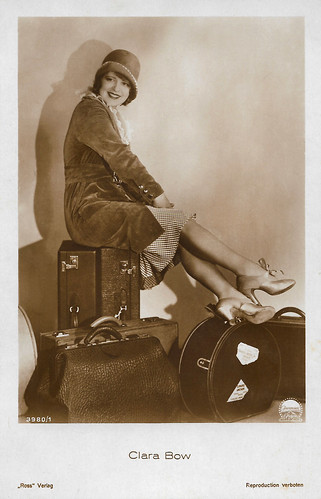
German postcard by Ross Verlag, no. 3980/1, 1928-1929. Photo: Paramount.

German postcard by Ross Verlag, no. 4107/3, 1929-1930. Photo: Paramount.
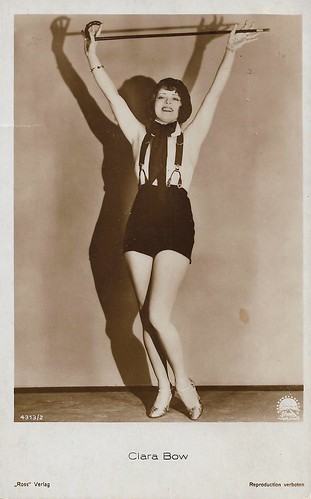
German postcard by Ross Verlag, no. 4313/2, 1929-1930. Photo: Paramount.

German postcard by Ross-Verlag, no. 4672/1, 1929-1930. Foto: Paramount.

German postcard by Ross-Verlag, no. 4672/3, 1928-1929. Photo: Paramount. Collection: Geoffrey Donaldson Institute.

German postcard by Ross-Verlag, no. 4672/4, 1928-1929.
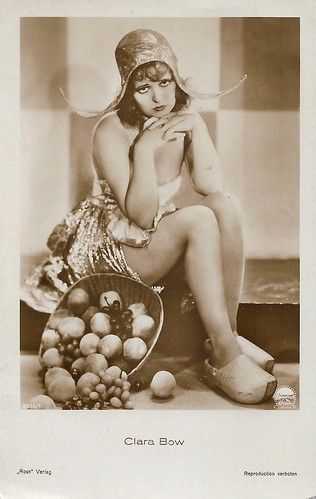
German postcard by Ross Verlag Berlin, no. 5393/1, 1930-1931. Photo: Paramount.

German postcard by Ross Verlag, no. 5749/1, 1930-1931. Photo: Paramount. Jack Oakie, Clara Bow, and Maurice Chevalier in Paramount on Parade (Dorothy Arzner a.o., 1930).

German postcard by Ross Verlag, no. 6382/2, 1931-1932. Photo: Paramount.
Sources: Denny Jackson (IMDb), Wikipedia, and IMDb.
This post was last updated on 25 July 2023.
No comments:
Post a Comment